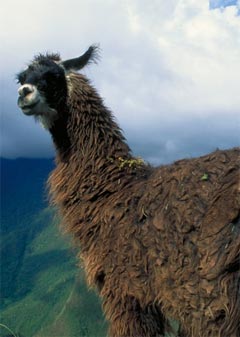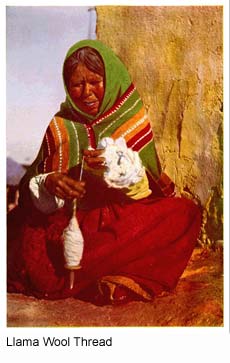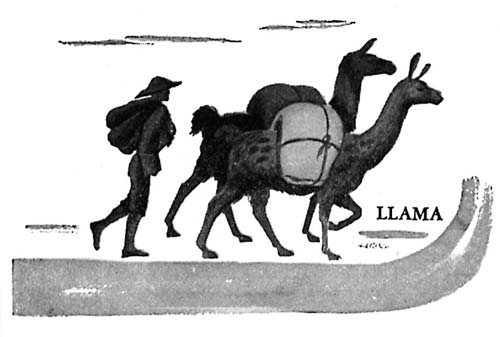|

 Just the Facts: The Llama skull generally resembles that of Camelus, the relatively larger brain-cavity and orbits and less developed cranial ridges being due to its smaller size. Just the Facts: The Llama skull generally resembles that of Camelus, the relatively larger brain-cavity and orbits and less developed cranial ridges being due to its smaller size.
The nasal bones are shorter and broader, and are joined by the premaxilla. Ears are rather long and pointed. There is no dorsal hump. Feet are narrow, the toes being more separated than in the camels, each having a distinct plantar pad. The tail is short, and fur is long and woolly.
One and the Same? In essential structural characters, as well as in general appearance and habits, all the animals of this genus very closely resemble each other, so that whether they should be considered as belonging to one, two, or more species is a matter of controversy among naturalists.
Cousins: wild and domestic... The llama and alpaca are only known in the domestic state, and are variable in size and color, being often white, black, or piebald. The guanaco and vicuña are wild and endangered, and of a nearly uniform light-brown color, passing into white below. They certainly differ from each other, the vicuña being smaller, more slender in its proportions, and having a shorter head than the guanaco.
Mountain Folk: The vicuña lives in herds on the bleak and elevated parts of the mountain range bordering the region of perpetual snow, amidst rocks and precipices, occurring in various suitable localities throughout Peru, in the southern part of Ecuador, and as far south as the middle of Bolivia. Its manners very much resemble those of the chamois of the European Alps; it is as vigilant, wild, and timid. The wool is extremely delicate and soft, and highly valued for the purposes of weaving, but the quantity which each animal produces is minimal.

Loveable Llamas: Llamas who are well-socialized and brought up by loving families are very friendly and pleasant to be around. They are extremely curious and most will approach people easily. Occasionally, llamas do spit at each other or people. The habit of spitting is a defense mechanism. However, usually, a llama would prefer to run away before confronting their assumed aggressor. The spitting behavior is believed to be a direct result of their usually shy disposition.
 Read the Spit: The sound of the llama making groaning noises or going "mwa" is often a sign of fear or anger. If a llama is agitated, she or he will lay his or her ears back. One may determine how agitated the llama is by the materials in the spit. Read the Spit: The sound of the llama making groaning noises or going "mwa" is often a sign of fear or anger. If a llama is agitated, she or he will lay his or her ears back. One may determine how agitated the llama is by the materials in the spit.
The more irritated the llama is, the further back into each of the three stomach compartments it will try to draw materials from, for its spit.
Beasts of Burden: One of the principal labors to which the llamas were subjected at the time of the Spanish conquest was that of bringing down ore from the mines in the mountains.
Gregory de Bolivar estimated that in
his day as many as three hundred thousand were employed in the transport of the produce of the mines of Potosí alone, but since the introduction of horses, mules, and donkeys, the importance of the llama as a beast of burden has greatly diminished.

 Camel Cousins: Although they were often compared by early writers to sheep and spoken of as such, their affinity to the camel was very soon perceived. They were included in the genus Camelus in the Systema Naturae of Linnaeus. They were, however, separated by Cuvier in 1800 under the name of Lama along with the alpaca and the guanaco. Vicuñas are in genus Vicugna. Camel Cousins: Although they were often compared by early writers to sheep and spoken of as such, their affinity to the camel was very soon perceived. They were included in the genus Camelus in the Systema Naturae of Linnaeus. They were, however, separated by Cuvier in 1800 under the name of Lama along with the alpaca and the guanaco. Vicuñas are in genus Vicugna.
The animals of the genus Lama are, with the two species of true camels, the sole existing representatives of a very distinct section of the "Artiodactyla" or even-toed ungulates, called Tylopoda, or "bump-footed," from the peculiar bumps on the soles of their feet, on which they tread.
Lost Llamas: It is now known that llamas at one time were not confined to the part of the continent south of the Isthmus of Panama, as at the present day, for their remains have been abundantly found in the Pleistocene deposits of the region of the Rocky Mountains, and in Central America, some attaining a much larger size than those now existing.
Some species of llamas did stay in North America during the last ice ages. 25,000 years ago, llamas would have been a common sight in modern-day California, Texas, New Mexico, Utah, Missouri, and Florida. These North American llamas belong to a single genera, Hemiauchenia, which is extinct.

All text is available under the terms
of the GNU Free Documentation License
|